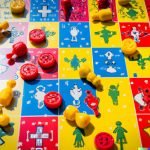Board games have long been a staple in family entertainment, but did you know that they also offer numerous benefits for the development of young children? When it comes to 4 year olds, classic board games are particularly suited to their cognitive and social growth.
These games not only provide valuable learning opportunities, but they also promote important skills such as problem-solving, turn-taking, and communication. In this article, we will explore why classic board games are great for 4 year olds and recommend some top choices that will engage and educate your little ones.
Playing board games at an early age has been shown to have a positive impact on children’s cognitive abilities. It helps them improve concentration, memory skills, number recognition, and decision-making skills. Additionally, board games encourage social interaction and cooperation among players.
They learn how to take turns, follow rules, communicate effectively, and work towards a common goal. For 4 year olds who are just beginning to understand the concept of sharing and playing with others, these games provide invaluable lessons in patience and sportsmanship.
Classic board games are specifically suitable for 4 year olds because they cater to their developmental stage. At this age, children are eager to explore new things but might not yet possess the attention span needed for more complex games. Classic board games often have simple rules and straightforward gameplay that is easy for young children to grasp.
The components are typically durable and designed with young hands in mind. Moreover, these timeless favorites have stood the test of time because they appeal to the imagination and interests of young children while still providing educational value.
In the next sections of this article, we will delve into the developmental stage of 4 year olds in greater detail and explore how playing classic board games can support their growth and learning. We will also recommend some popular classic board games for 4 year olds, discuss their educational value and entertainment factor, and provide tips for parents on how to engage and support their children during board game sessions.
So let’s dive in and discover the joy and benefits of classic board games for our 4 year olds.
Understanding the Developmental Stage of 4 Year Olds
At the age of 4, children are going through an important period of growth and development. Understanding their cognitive, emotional, and physical development can help parents choose appropriate activities to support their learning and ensure they have a positive experience. Classic board games are particularly beneficial for 4 year olds as they provide opportunities for social interaction, cognitive skills development, and fine motor skill enhancement.
Cognitive Development
During this stage, 4 year olds are expanding their cognitive abilities rapidly. They are able to understand more complex concepts, follow multi-step directions, and engage in imaginative play. Classic board games like Snakes and Ladders or Memory Match can help strengthen their memory skills, promote decision-making abilities, and encourage logical thinking.
Emotional Development
4 year olds are also building their emotional awareness and gaining better control over their emotions. Sharing toys, taking turns, and practicing good sportsmanship are important aspects of their emotional development. Board games such as Chutes and Ladders or Trouble provide opportunities for them to practice patience, learn how to win graciously, and cope with disappointment when they lose.
Physical Development
Fine motor skills continue to develop at the age of 4 and classic board games can help nurture these skills. Games that involve moving game pieces or picking up cards can improve hand-eye coordination and finger dexterity. The game Trouble, for example, requires players to press a bubble in order to roll the dice, which helps enhance finger strength and control.
By understanding the developmental stage of 4 year olds, parents can choose classic board games that are not only entertaining but also aligned with their child’s abilities. These games provide an ideal platform for learning while having fun with family or friends.
Top Classic Board Game Recommendations for 4 Year Olds
When it comes to board games for 4 year olds, classic options are a wonderful choice. Not only do these games provide entertainment, but they also offer numerous educational benefits. Here are some of the top classic board game recommendations that are perfect for 4 year olds:
- Snakes and Ladders: This timeless game is a hit among 4 year olds. The rules are simple – players roll a dice and move their piece along the board, trying to reach the finish first. Along the way, they encounter snakes that send them back and ladders that help them progress.
Snakes and Ladders helps develop numerical skills as children learn to count spaces on the board. It also enhances decision-making abilities as they strategize their moves. - Candy Land: Enter a colorful world filled with sweets in Candy Land. Designed specifically for young children, this game encourages imagination and color recognition. Players draw cards that determine how many spaces to move forward, making it easy for 4 year olds to understand and participate in the game. Turn-taking skills are also honed as children wait patiently for their next chance.
- Memory Match: Memory Match is not only fun but also enhances concentration and memory skills in 4 year olds. The game consists of pairs of cards placed face-down on a table or floor, which players then take turns flipping over to find matching pairs. Children have to remember the location of each card they uncover in order to make successful matches. Playing Memory Match regularly can help improve cognitive abilities and focus in young children.
These classic board games provide both educational value and entertainment factor for 4 year olds. They promote important skills such as numeracy, decision-making, imagination, color recognition, concentration, memory, patience, and turn-taking. Introducing these games to your child’s playtime routine can be a valuable way to support their growth and learning while having a great time together.
Snakes and Ladders
Snakes and Ladders is a classic board game that has been enjoyed by children for generations. Its simple gameplay and exciting elements make it a popular choice for 4 year olds. This game not only provides entertainment but also offers several developmental benefits for young children.
The rules of Snakes and Ladders are easy to understand, making it accessible to 4 year olds who may still be learning how to follow instructions. The game involves rolling a dice and moving across the board, aiming to reach the finish line first. However, the presence of snakes and ladders adds an element of surprise, creating anticipation and excitement for the players.
One of the key benefits of playing Snakes and Ladders is its ability to enhance numerical skills in 4 year olds. As they count the number on the dice and move their piece accordingly, they develop their understanding of numbers and basic mathematics. Additionally, this game also improves decision-making abilities as children have to strategize which direction to move in order to avoid snakes or reach a ladder.
| Benefit | Description |
|---|---|
| Development of numerical skills | Counting dots on dice, understanding number values |
| Enhancement of decision-making abilities | Strategizing movement based on board layout |
Furthermore, Snakes and Ladders can also teach young children about sportsmanship as they learn how to handle both winning and losing with grace. This game provides opportunities for parents or caregivers to discuss emotions such as disappointment or happiness, helping children develop emotional intelligence.
Candy Land
Candy Land is a classic board game that has captured the hearts and imaginations of children for generations. This enchanting game takes players on a colorful adventure through a whimsical world filled with candy-themed characters and landscapes. Designed specifically for young children, Candy Land is not only entertaining but also offers numerous educational benefits for 4 year olds.
One of the key skills that Candy Land helps develop in 4 year olds is color recognition. Each space on the game board corresponds to a specific color, and players must match their card to the corresponding space. This simple matching activity helps reinforce color identification skills in a fun and engaging way. Additionally, the vibrant visuals of Candy Land stimulate children’s visual perception and improve their ability to differentiate between various shades.
Another important skill that Candy Land helps foster in 4 year olds is turn-taking. The game follows a simple structure where each player takes turns drawing cards and moving their pawn along the colored spaces. By waiting patiently for their turn and taking turns with other players, children learn valuable social skills such as patience, sharing, and respect for others’ playtime.
In terms of cognitive development, Candy Land promotes basic counting skills as players move their pawns along the board. Each card requires players to move a certain number of spaces forward or backward, allowing 4 year olds to practice counting from one to ten. This not only reinforces early numeracy skills but also enhances their understanding of number sequencing and quantity.
Overall, Candy Land provides an immersive and interactive learning experience that combines entertainment with valuable educational outcomes for 4 year olds. Through its vivid visuals, color recognition activities, turn-taking dynamics, and basic counting exercises, this classic board game nurtures important developmental skills in an enjoyable way.
| Benefits | Description |
|---|---|
| Color recognition | Players match their cards to colored spaces, reinforcing color identification skills. |
| Turn-taking | The game structure helps children learn patience, sharing, and respect for others’ playtime. |
| Counting skills | Candy Land allows players to practice basic counting from one to ten as they move their pawns along the board. |
Memory Match
Memory Match is a classic board game that is not only entertaining but also provides numerous benefits for the cognitive development of 4 year olds. This game is designed to enhance concentration and memory skills, making it an ideal choice for young children who are just beginning to develop these important abilities.
Memory Match typically consists of a set of cards with matching pairs. The cards are laid out face down on a table or playing surface, and players take turns flipping over two cards at a time in an attempt to find matching pairs. If a match is found, the player keeps the pair and gets another turn. If not, the cards are turned back face down and it becomes the next player’s turn.
One of the primary benefits of Memory Match is its ability to improve concentration. 4 year olds are often easily distracted and may struggle with focusing their attention on one task for an extended period of time. Playing Memory Match requires players to pay close attention to details and remember the location of specific cards in order to make matches. This helps children practice their concentration skills while having fun at the same time.
Additionally, Memory Match is a great tool for enhancing memory skills in 4 year olds. The game encourages players to remember where certain cards are located so they can eventually make successful matches. This requires them to use their short-term memory to recall information as they progress through each turn. By engaging in this type of memory exercise regularly, children can strengthen their ability to retain information and recall it when needed.
To fully maximize the educational aspect of Memory Match, parents can implement several strategies during gameplay. First, it’s important to start with a smaller number of cards and gradually increase the difficulty level as their child becomes more skilled at remembering matches. Additionally, parents can encourage verbalization by asking their child to describe what they saw on each card before turning them over. This helps reinforce memory retention by incorporating verbal cues alongside visual stimuli.
Chutes and Ladders
Chutes and Ladders is a classic board game that has been enjoyed by generations of children. This game combines fun and learning in a way that is especially beneficial for 4 year olds. The mechanics of the game are simple, making it easy for young children to understand and participate in.
The objective of Chutes and Ladders is to be the first player to reach the finish line at the top of the board. Players take turns spinning a spinner or rolling a dice to determine how many spaces they move forward. Along the way, they may encounter ladders that allow them to climb ahead more quickly or chutes that send them sliding back down the board.
One of the main educational benefits of Chutes and Ladders is its ability to develop counting skills in 4 year olds. As they move their game pieces along the board, children must count each space they progress, reinforcing number recognition and sequencing. Additionally, this game promotes patience and good sportsmanship as players have to wait for their turn and accept both ups and downs with a positive attitude.
To further enhance the learning aspect of Chutes and Ladders, parents can engage their 4 year olds in conversation during gameplay. They can ask questions like “How many spaces did you move?” or “Can you count how many ladders are on the board?”. This not only reinforces counting skills but also encourages cognitive development through critical thinking and problem-solving.
Trouble
Gameplay and Laughter
Trouble is a classic board game that offers a hilarious dice-rolling experience for 4 year olds. The objective of the game is to move all four of your colored pegs around the game board and into your “home” base before any opponents can do the same.
Players take turns rolling a single die, and if they roll a six, they can place one of their pegs onto the starting space. From there, players move their pegs by the number shown on the die.
One of the reasons why 4 year olds love Trouble is because it involves pressing down on a plastic bubble to roll the dice. This action alone can create excitement and anticipation as they wait to see what number they roll. In addition, the movement of the pegs around the board is often accompanied by funny sound effects, which adds to the overall enjoyment of the game.
The element of chance in Trouble also adds to its hilarity. Since players rely on dice rolls to determine how many spaces they can move, there are times when they may end up landing on spaces occupied by opponents’ pegs. When this happens, those opponents’ pegs are sent back to their respective starting spaces. This unexpected twist can elicit laughter and create a sense of friendly competition among players.
Improving Skills through Gameplay
Besides providing laughter-inducing moments, Trouble also helps develop various skills in 4 year olds. As players engage in gameplay, they have opportunities to practice fine motor skills such as gripping and releasing objects when popping the plastic bubble or moving their pegs along the board.
Counting is another skill that is reinforced throughout this game. With each roll of the die, players must count out loud or mentally determine how many spaces their pegs should move forward. This repetitive counting helps reinforce numerical concepts and improves basic counting abilities in young children.
Strategic thinking is also encouraged in Trouble. Players must decide which peg to move and how to navigate their way around the board to reach their home base while also avoiding opponents’ pegs. This introduces basic decision-making skills and fosters critical thinking abilities in 4 year olds.
Parental Guidance
Playing classic board games with 4 year olds can be a rewarding and educational experience for both children and parents. However, it’s important for parents to provide the necessary guidance and support during these game sessions to ensure that their child is engaged, learning, and having fun. Here are some tips and strategies for parents to encourage and support their 4 year olds during board game sessions:
- Choose age-appropriate games: When selecting board games for your 4 year old, make sure to choose ones that are suitable for their developmental stage. Look for games that involve simple rules, easy-to-understand concepts, and short gameplay durations. This will help keep your child’s attention span intact and prevent frustration.
- Set clear expectations: Before starting a game, take a moment to explain the rules, objectives, and how the game is played. Use simple language and visual aids if needed. Encourage your child to ask questions if they don’t understand something. Setting clear expectations from the beginning will help your child feel more confident and engaged in the game.
- Be patient and supportive: Remember that playing board games with a 4 year old is not just about winning or losing; it’s about having fun and learning together. Be patient with your child as they navigate through the game mechanics and decision-making process. Offer encouragement along the way and praise their efforts, regardless of the outcome.
- Teach good sportsmanship: Board games provide an excellent opportunity to teach young children about fairness, patience, taking turns, and being a good sport whether they win or lose. Reinforce positive behavior by applauding them for displaying good sportsmanship during gameplay.
- Make it a family affair: Instead of playing against or competing solely with your child, consider making board game sessions a family activity where everyone can participate. This creates a sense of togetherness and strengthens family bonds. Encourage teamwork, communication, and collaboration among family members during gameplay.
- Tailor the experience to your child’s interests: To keep your child engaged and excited about board games, consider selecting games that align with their interests and preferences. Whether it’s animals, princesses, or shapes, choosing games that incorporate these themes can make the gaming experience more enjoyable for your 4 year old.
By following these tips and strategies, parents can create a positive and enjoyable board game experience for their 4 year olds. Remember that the ultimate goal is to foster learning, cognitive development, social skills, and quality time together as a family.
Conclusion
In conclusion, classic board games are truly timeless treasures for 4 year olds. Throughout this article, we have explored the numerous benefits of playing these games, from improving cognitive and social skills to supporting overall growth and learning. Classic board games provide an excellent opportunity for young children to have fun while developing important skills that will serve them well in their future.
By understanding the developmental stage of 4 year olds, we can see how playing classic board games aligns perfectly with their cognitive, emotional, and physical development. These games engage their minds, encourage cooperation and turn-taking, and help them practice important concepts such as counting and memory.
The top recommended classic board games for 4 year olds have been carefully selected for their educational value and entertainment factor. Whether it’s the numerical and decision-making abilities enhanced by Snakes and Ladders or the imagination-stimulating adventure of Candy Land, each game offers unique benefits that contribute to a child’s overall development.
Therefore, it is highly encouraged for parents to introduce these classic board games to their 4 year olds. Not only will it be a great bonding experience for the whole family, but it will also provide an avenue for children to build essential skills in a fun and engaging way. Classic board games truly are timeless treasures that every 4 year old should have the chance to enjoy.
Frequently Asked Questions
What board game can a 4 year old play?
A board game that a 4-year-old can play is “Candy Land.” This classic children’s game is designed specifically for young kids and does not require any reading skills or complex rules.
The colorful board features different locations, and players move their characters along the path by drawing cards with different colors. It helps children learn basic color recognition, counting, and taking turns while offering a fun and engaging experience.
What are traditional board games?
Traditional board games refer to those that have been around for many years and have become well-known classics. Examples of traditional board games include “Monopoly,” “Scrabble,” “Chess,” “Checkers,” and “Clue.”
These games often involve strategic thinking, planning, problem-solving, and social interaction. They are widely recognized and played by people of various ages across generations, making them timeless favorites in the world of board gaming.
What are old fashioned children’s indoor games?
Old-fashioned children’s indoor games were popular before the advent of technology-based entertainment options. These games aimed to engage children’s creativity, physical activity, and imagination. One such game is “Duck Duck Goose,” where kids sit in a circle while one child walks around tapping others’ heads and saying “duck.”
Eventually, they choose someone as the “goose” who gets up to chase after them around the circle. Another common old-fashioned game is “Cat’s Cradle,” which involves intricate string formations created between two people using just their hands. These types of games encouraged social interaction, imaginative play, and physical coordination among children indoors before modern distractions took over.

I love playing all kinds of games – from classics like Monopoly to modern favourites like Ticket to Ride.
I created this blog as a way to share my love of board games with others, and provide information on the latest releases and news in the industry.





